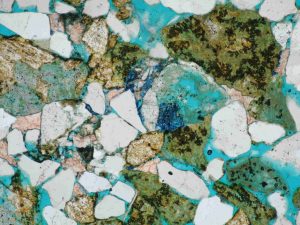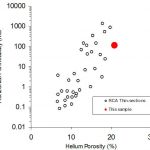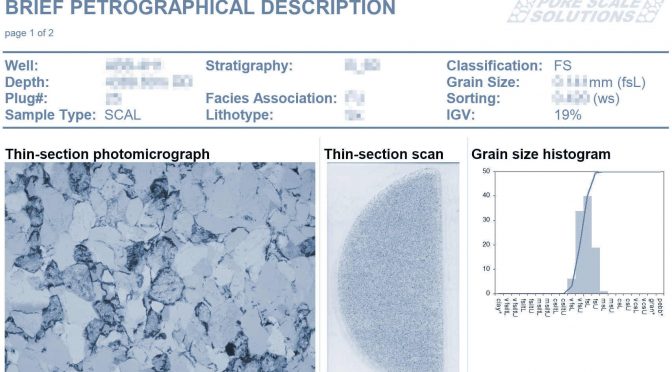We offer sample descriptions at a range of level of detail, from summary descriptions focussed on a specific set of feature(s) in a sample or sample set, up to completely-comprehensive characterisation of all aspects of the sample.

Most of the descriptive work is carried out using optical (plane-polarised light) light microscopy. However, additional detail will usually be added using scanning electron microscopy and other microscopy methods as required. Any additional micrcoscopy observations are incorporated directly into the sample descriptions (and not presented as separate descriptions).
There is always a temptation to “scrimp-and-save” a little on this aspect of petrographical studies, but this is the time where the real detail and intricacies of samples can be investigated and documented.
For clastic sediments (other sediments are also available), our descriptions are typically subdivided into sections including:
Texture and Overview – this provides details on the sediment grain size and sorting (also see Textural Analysis), primary fabrics (e.g. lamination) and disruption of primary fabrics (e.g. bioturbation and dewatering), grain packing (overall degree of grain-contact elongation and general degree of compaction). It also includes an overview of other important sandstone characteristics and reservoir quality.
Detrital Material – The original composition of the sediment provides information on variations in sediment provenance and/or depositional environments through a sedimentary sequence. The original composition of the sediment also strongly influences how the sediment will behave on burial and during diagenesis. However, diagenetic effects may significantly overprint the detrital mineralogy, obscuring its original composition.
- Framework components – this describes the character and distribution of detrital, rigid (non-deformable) material in the sediment which typically includes grains of quartz, feldspar, rock fragments, bioclasts, heavy minerals.
- Ductile components – this describes the character and distribution of detrital, ductile (plastically-deformable) material in the sediment. It typically includes: detrital clay and intraformational clay-rich grains (e.g. rip-up clasts, ooids, peloids and glauconite pellets) as well as extraformational material such as grains of mica, mica-schist.

Diagenetic Components– this section describes the character and distribution of mineral material and secondary pore spaces that developed in the sediment post-deposition. This section of the description provides information on:
- The character and distribution of diagenetic components and the resulting impact on pore systems.
- The inferred original composition of detrital material that has been replaced by authigenic material.
- Any relationships between detrital material and diagenetic effects (e.g. inhibition of quartz overgrowth development by clay coatings).
- Distribution and character of any fracture-related diagenetic effects (including “open” fractures, cemented fractures, as well as granulation seams / compaction bands / micro-faults).
- Dissolution effects and the inferred original character of dissolved components.

Paragenetic relationships – throughout the characterisation of the samples (including during initial sample screening, textural analysis and modal analysis) attention is paid to paragenetic relationships between diagenetic / authigenic components. These are documented on a sample-by-sample basis in the sample descriptions, and the resulting observations are compiled into an overarching paragenetic sequence for the interval(s) in question – linked to burial histories and geochemical data [e.g. fluid inclusion results] where available.
Pore Systems and Controls on Reservoir Quality – this part of a sample description documents the abundance, size, distribution and overall connectivity of primary and secondary pores. It also considers the relative significance and distribution of macro- and micro-pores.
In addition to characterising the pore system, this part of the description also aims to explain how the pore system attained its current configuration. In oil and gas-related studies, this is typically the most important part of the sample description.
 Wherever possible, this part of the description also provides commentary on how an individual petrographical sample relates to the (larger) routine core analysis sample set.
Wherever possible, this part of the description also provides commentary on how an individual petrographical sample relates to the (larger) routine core analysis sample set.
In addition, our sample descriptions always incorporate at least one photomicrograph, as well as all the textural, modal and routine core analysis data that is available for the sample under consideration. Depending upon the aims of the project, the descriptions may be augmented by additional photomicrographs and additional observations, data, and charts derived from other analyses (e.g. X-ray Diffraction, pore image analysis, MICP etc…).

